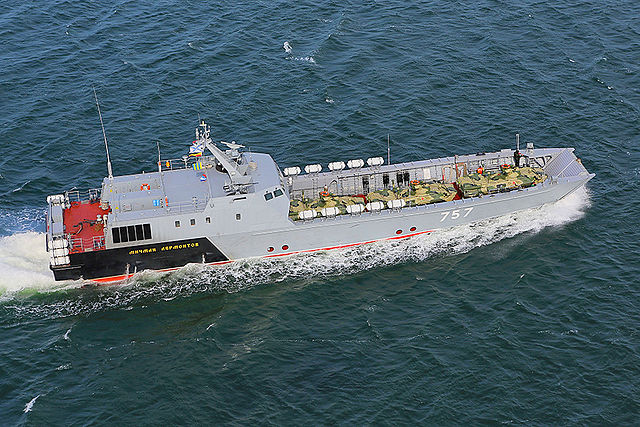Dyugon-class
Summary
| Origin country | 🇷🇺 Russia |
| Category | Amphibious vessel |
| Subtype | Landing craft |
| Manufacturer | OJSC Vostochnaya Verf in Vladivostok (1), OJSC Shipbuilding Plant Volga in Nizhny Novgorod (1), , OJSC Yaroslavl Shipyard in Yaroslavl (3) |
| Year commissioned | 2010 |
| Units |
Ataman Platov Denis Davydov Ivan Kartsov Lieutenant Rimskiy-Korsakov Midshipman Lermontov |
| Current operators | 🇷🇺 Russia |
Description
The Dyugon-class landing craft, known by the Project 21820, comprises a series of five air-cavity landing craft currently in service with the Russian Navy. These vessels are intended for marine landing operations, delivering troops, equipment, and cargo to unequipped shores, which they can access due to their air-cavity hull design. This allows the crafts to reduce water resistance, enabling faster speeds and more efficient performance during landings.
The development of the Dyugon-class stems from the Russian Navy's requirements for modern and capable landing craft. Over time, five of these crafts have been built and incorporated into the Russian naval forces. As with many military projects, the origins of these landing crafts are tied closely to the strategic operational needs they were designed to fulfill, which include enhanced adaptability in various marine conditions and the requirement for rapid deployment capabilities.
With regard to design, the Dyugon-class is distinctive due to its air-cavity hull. This unique design feature creates an air bubble under the vessel's hull to reduce drag, which permits it to achieve higher speeds and improved maneuverability. This also allows the craft to maintain effectiveness while operating in both littoral zones and deeper waters, serving versatile roles in military operations.
There is little detailed information provided about the specific armament of these crafts. However, in general, such vessels are often equipped with machine guns and other defensive weaponry to protect the craft and its occupants during landing operations and while in hostile environments.
Despite the advanced design of the Dyugon-class, the vessels have faced criticism regarding their construction and performance. Reports surfaced after sea trials of the first craft in the Caspian Sea that suggested serious design flaws and shoddy workmanship. Complaints included issues like cracks developing in the hull when the vessel was traveling at high speeds, resulting in risks of the craft breaking apart. This led to notable controversies, as highlighted by the Russian newspaper Izvestija, which pointed out that construction orders for the vessels were divided among several shipyards for socio-economic reasons rather than efficiency or quality control. Specifically, the distribution of orders was supposedly to keep the shipyards busy, despite some not having experience with building air-cavity vessels.
In their operational history, these landing craft, each named after historical figures or events, have become part of various fleets within the Russian Navy including the Pacific Fleet, the Baltic Fleet, and there are documented examples of one craft being tested in the Caspian Sea. The series includes vessels with names that honor heroes of the war of 1812 or are associated with Russian history.
Concerning the operating countries, to date, the Dyugon-class landing craft are operational exclusively within the Russian Navy and there are no records indicating exports or service with other nations. This specialized nature of the craft might suggest a limited operational scope, focused primarily on the strategic requirements of Russia's naval capabilities.
Technical specifications
| Displacement | 280 tons |
| Range | 900 km |
| Crew | 7 members |
| Width | 8.6 m (28.2 ft) |
| Length | 45.0 m (147.6 ft) |
| Propulsion | 2 9,000 hp M507A-2D diesel engines |
| Armament | 2 KPV 14.5 mm machine guns |
| Maximum speed | 35 knots |
